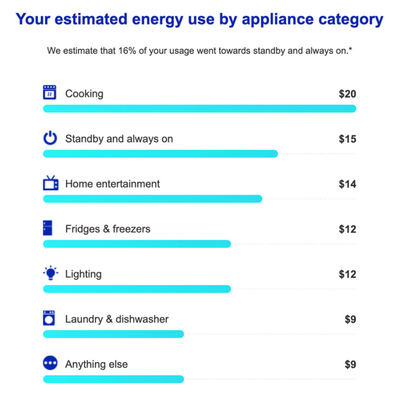There are only two ways to slash your energy bill: pay less for power, and use less power. So let’s look at both of them.
1. Pay less for power
There are only two ways to do this: switch to a cheaper plan or go solar.
switch
Over 450,000 households switched energy providers in June and July 2022 – a new record for any two-month period.
It’s possible to save hundreds of dollars in under 10 minutes by switching to a cheaper deal.
Start at the government websites energymadeeasy.gov.au or compare.energy.vic.gov.au – you can even upload your last email bill, which saves you putting in all the details.
READMORE: Socialite ‘outrage’ over Fergie’s ‘dirty’ $12 million purchase

You can also check out special offers at One Big Switch (where I work), some motoring clubs, and via loyalty programs such as Westpac or CBA.
Once you find a good deal, you can switch over in minutes if you’re in NSW, VIC, SA, SEQLD, Tasmania or ACT and it could save you hundreds of dollars.
If it’s a fixed rate for 12 months, simply set and forget – but put a reminder in your diary for when it expires.
If it’s a variable rate, just be prepared to switch again if it becomes uncompetitive. There’s no cost to switch.
Solar
We’re also breaking records in this area: In 2020 and 2021, Aussies installed a record amount of new solar panels on rooftops.
With power prices skyrocketing in 2022, we might be on track to break the record again.
An average-sixed system is now about 6.5-8kw, which could cost anywhere from $4000-$10,000 upfront, depending on the brands of hardware, where you live and the difficulty of the installation.

But there are now a range of ways to pay for solar, from green loans with rates below 10 per cent, to zero-interest Buy Now Pay Later schemes, and ‘power purchase agreements’.
Check out my Go-Solar Checklist here with more details on how to choose panels, inverters, installers and batteries.
READMORE: Anne Heche ‘joked’ about drinking in podcast before horror crash
2.Use less power
If you don’t live in a switching state or you don’t have the opportunity to go solar, using less is your only option.
Start with the low-hanging fruit, the big energy-guzzlers. Then move onto the smaller suckers, such as “vampire power”.
energy-guzzlers
The big three are heating/cooling, hot water, and pools. Make these as efficient as possible and it can save you hundreds or even thousands of dollars.
Heating and cooling, for example, can make up 30-40 per cent of a winter or summer bill. Set your thermostat at 22-24 degrees when heating and 18-20 degrees when cooling your home. Only go further if necessary. Every extra degree can add 10 per cent or about $100 to your bill.
Pool pumps will cost a lot less if you can opt for a ‘time of use’ tariff and run them in off-peak hours or run them on a cheaper “controlled load” circuit. Ask your energy provider.
Hot water will be cheaper if you turn the thermostat down to 50 degrees rather than 60 or 70.
smaller suckers
Clothes dryers are not very energy-friendly. Use the clothesline where possible, and/or do your drying during off-peak periods (or during the day, if you have solar).
Do your washing and dishwashing at night too if you have a plan with off-peak rates.
Appliances on standby can use up as much as 10 per cent of an average home’s electricity. They call it “vampire power” – see the example below – so switch them off when you’re not using them.
READMORE: Neighbor’s passive-aggressive parking note praised for its creativity

Turn off the old, half-full, inefficient beer fridge in the garage, which can cost around $250 a year to run. Just turn it on a few days before Christmas.
Think you’ve tried everything? Run through this list of 101 ways to reduce your energy bill.
Government deductions, concessions and rebates
Finally, check if you’re eligible for hundreds and sometimes thousands of dollars in tax deductions, concessions and rebates from state and federal governments.
Claim as much as possible on tax if you’re working from home. For example, the ATO’s ‘shortcut method’ created for the pandemic was extended to cover the most recent tax year – so you can just count your WFH hours and multiply by 80c to get up to about $1500 a year in deductions.
Or ask your accountant to use the traditional methods, which might add up to more deductions than the shortcut method.

Check at energy.gov.au or this list I created here for any concessions or rebates you’re entitled to – pensioners, concession card holders and low income households can access hundreds of dollars in energy bill relief in some states.
Self-funded retirees might qualify for a Commonwealth Seniors Health Card, which is income-tested not asset-tested, and in NSW that entitles you to a $200 Seniors Rebate.
And if you’re doing anything to make your home more energy-efficient, such as installing solar or batteries, replacing downlights with LEDs, or buying more efficient appliances, state governments will often help you with rebates so check out energy.gov.au or this list I created here for more info.
Joel Gibson is a regular on Today, Nine Newspapers columnist, money-saving expert at One Big Switch and author of Kill Bills!
For a daily dose of 9Honey, subscribe to our newsletter here.

Top 10 money hacks for saving cash at Australian stores